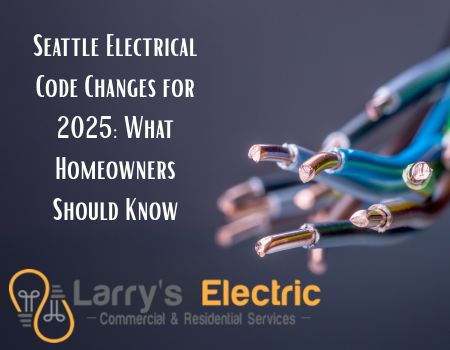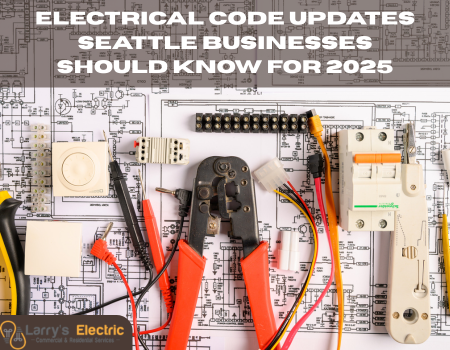As of early 2025, Seattle has officially adopted the 2023 edition of the National Electrical Code (NEC) along with locally specific amendments through the Washington Cities Electrical Code. For homeowners, these changes are more than technical adjustments. They directly affect safety, remodeling projects, EV installations, and even insurance coverage. Understanding what’s new helps you stay compliant and avoid costly surprises.
Expanded GFCI and AFCI Coverage
One of the most noticeable electrical code updates involves Ground-Fault Circuit Interrupters (GFCIs) and Arc-Fault Circuit Interrupters (AFCIs).
GFCIs are now required on nearly all 125- to 250-volt receptacles in bathrooms, kitchens, garages, unfinished basements, wash areas, and outdoor spaces—even if the outlet is not directly near water. Similarly, AFCI protection now extends to more circuits, including those serving bedrooms, living rooms, dining areas, laundry rooms, and utility spaces.
These electrical code changes are designed to reduce both shock and fire risks. However, they also mean that older electrical panels may need upgrades or replacements to accommodate the new breaker types.
Whole-House Surge Protection
The 2025 code now requires Whole-House Surge Protective Devices (SPDs) for all newly installed or replaced electrical service panels in single-family or two-family dwellings. Surge protection is no longer an optional safety feature—it’s a baseline expectation.
In a city like Seattle, where many homes are filled with sensitive electronics and smart devices, this update provides added peace of mind. It also protects homeowners from unexpected losses that insurance companies may be hesitant to cover if surge protection is absent.
Outdoor Emergency Disconnects
Another new electrical code requirement is the installation of an outdoor emergency disconnect on all service panels for one- and two-family homes. This change, based on NEC 230.85, ensures that first responders can quickly and safely cut power from outside the house in case of fire, flooding, or other emergencies.
For homeowners, it’s a simple upgrade that significantly improves safety for both residents and emergency crews.
EV-Ready Circuits and 240-Volt Capacity
With Washington State’s commitment to cleaner transportation, the 2025 code reflects a growing push toward electric vehicle readiness. New homes and remodels must now include electrical infrastructure capable of supporting Level 2 EV chargers. Specifically, builders are required to provide a dedicated electrical service terminated at a junction box or receptacle near parking spaces.
Existing homeowners planning to add an EV charger should verify whether they already have a dedicated 240-volt circuit. In many cases, older homes will need panel upgrades to handle the added load. While this may feel like an extra cost, it ensures your home is ready for both EV adoption and other high-demand appliances like heat pumps.
Panel Upgrades and Load Calculations
Seattle’s 2025 code also tightens requirements for load calculations. With households using more electricity than ever before—from EVs to solar storage to backup generators—panels must be sized correctly to handle demand.
For many older homes still relying on 100-amp service, this means upgrading to a 200-amp panel. Electricians are now required to evaluate load with greater precision, which helps prevent overloaded circuits and future hazards.
Why These Changes Matter
At the heart of these electrical code updates is safety. Expanded GFCI and AFCI coverage reduces shock and fire hazards. Whole-house surge protection safeguards your electronics against unpredictable spikes. And emergency disconnects make it easier for first responders to protect both people and property.
But the changes are not only about safety. They also help future-proof homes for modern living. EV-ready circuits, stronger load calculations, and panel upgrades make it easier to adopt clean energy, install new appliances, and increase property value.
For homeowners thinking about selling, compliance matters even more. Inspectors, insurers, and buyers are paying attention to electrical systems. Falling behind on code requirements could delay renovations, increase insurance premiums, or reduce your home’s resale appeal.
How Homeowners Can Prepare
If you live in Seattle, the best way to prepare is to schedule an electrical inspection—especially if your home was built before 2000 or still uses outdated panels like Federal Pacific or Zinsco. Consider upgrading to a modern breaker box that can handle GFCI, AFCI, and surge protection requirements.
If you’re planning on buying an EV, talk to a licensed electrician about installing a dedicated 240-volt circuit or upgrading to a 200-amp panel. Even if you’re not adding an EV today, preparing your home now makes it easier and less expensive later.
Finally, keep records of all inspections, upgrades, and permits. Documentation not only ensures compliance with electrical codes but also protects you during insurance claims or property sales.
Seattle’s adoption of the 2025 electrical code aligns local standards with the latest NEC updates, bringing important changes for safety, energy use, and home value. From expanded GFCI and AFCI requirements to whole-house surge protection, outdoor disconnects, EV-ready wiring, and stricter load calculations, these updates reflect the realities of modern living.
For homeowners, the message is clear: stay proactive. A simple inspection and strategic upgrades now can protect your family, reduce risks, and keep your home ready for the future.



